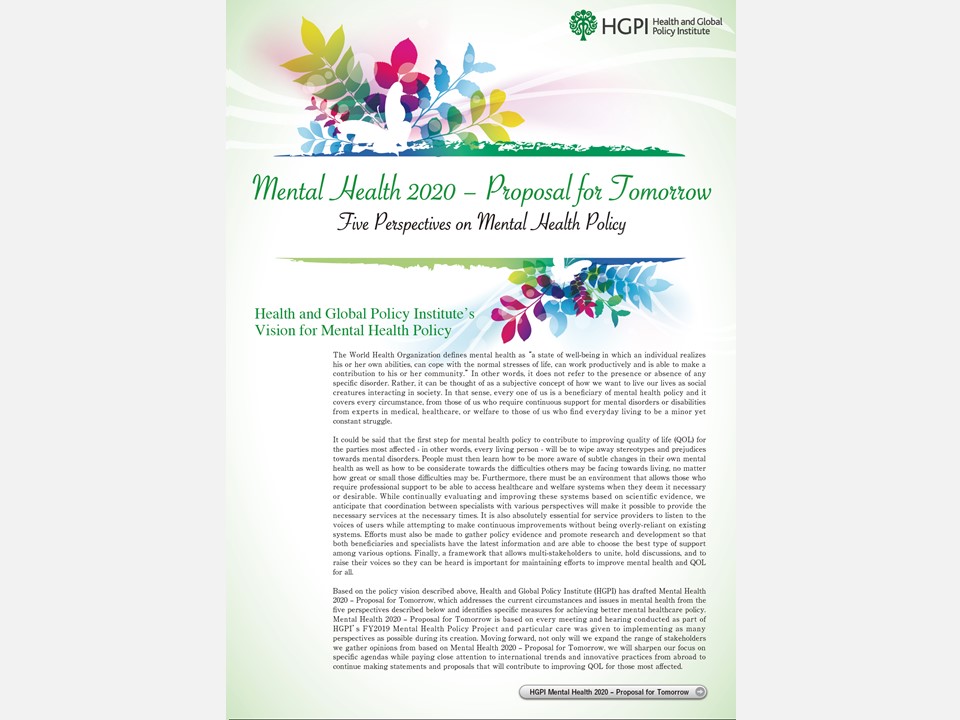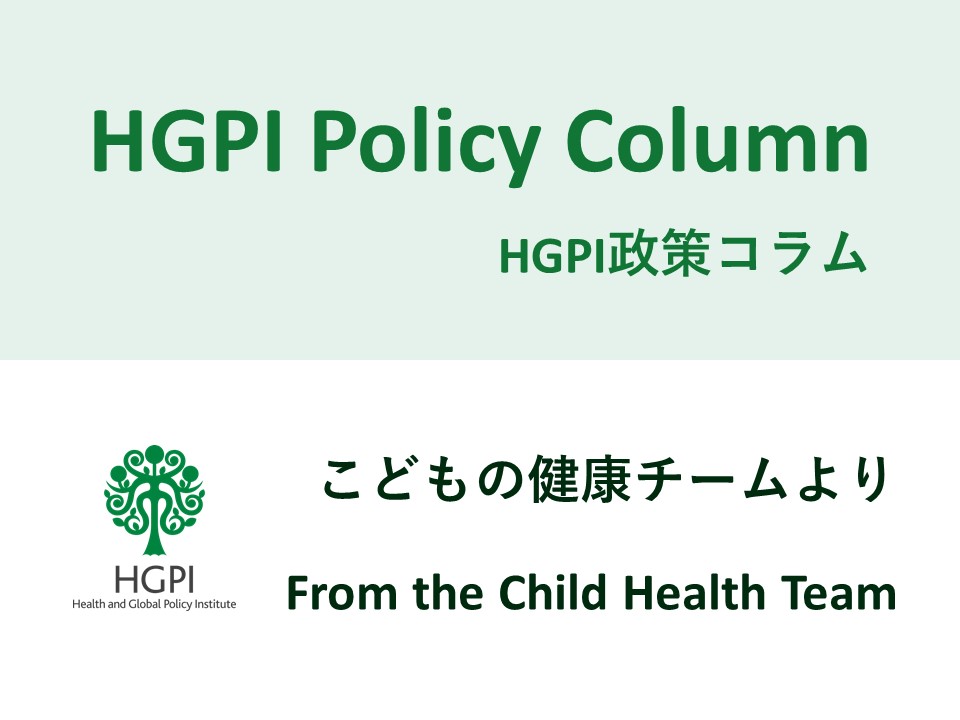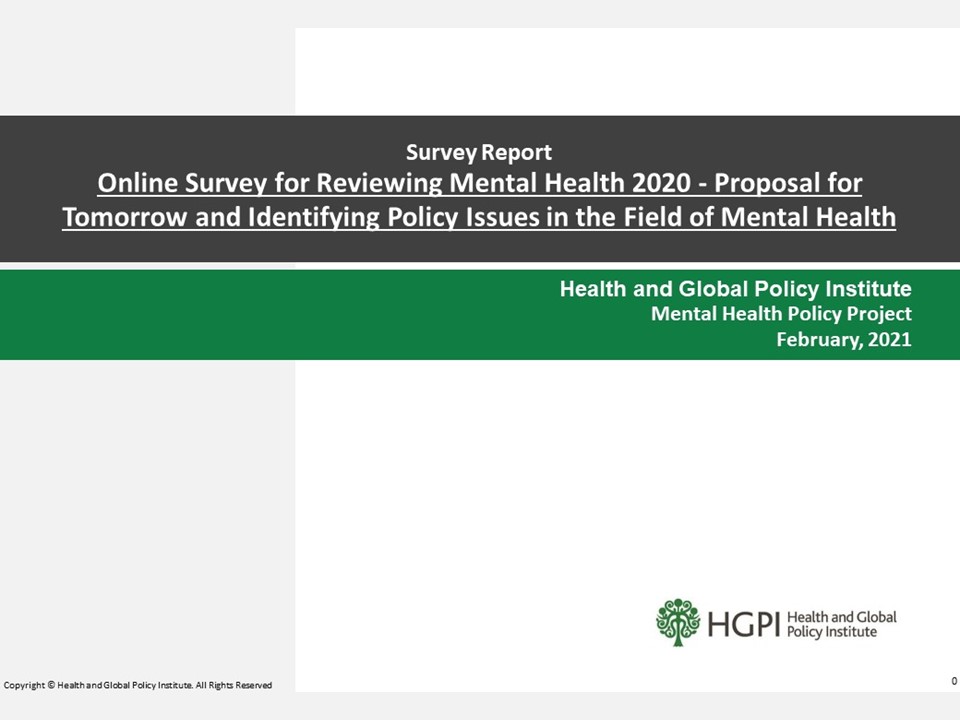[HGPI Policy Column] (No.41) — From the Mental Health Project “Mental Health Policy in Japan — History and Future Policy Topics (Part 1 of HGPI Activities for Mental Health and Domestic Policy History)”
date : 3/5/2024
Tags: HGPI Policy Column, Mental Health
![[HGPI Policy Column] (No.41) — From the Mental Health Project “Mental Health Policy in Japan — History and Future Policy Topics (Part 1 of HGPI Activities for Mental Health and Domestic Policy History)”](https://hgpi.org/en/wp-content/uploads/sites/2/column-41-top-1.png)
<POINTS>
- The increase in the number of people living with mental disorders means mental health policy is now more important than ever before.
- Health and Global Policy Institute (HGPI) began its efforts for mental health policy in 2019. Our project aims to generate policy recommendations that encompass the perspectives of citizens and affected parties and targets all items related to mental health.
- While efforts for mental health policy in Japan have been ongoing for many years, there are many lingering issues. Based on past developments in this area, we must reflect on history as we advance future measures.
Introduction
This column will be our first in a three-part series on mental health policy. The number of people diagnosed with mental disorders is increasing every year. According to the Patient Survey conducted by the Ministry of Health, Labour and Welfare (MHLW), in 2017, a total of 4,193,000 people were being treated for mental health in Japan (3,891,000 outpatients and 302,000 inpatients). While the number of hospitalized people has gradually decreased over the past fifteen years, the number of people receiving outpatient care has been on an upward trend as has the total number of people receiving mental health care. (Despite a change in tabulation method, this trend was also visible in the 2020 Patient Survey findings.) Depending on the framing, policies related to mental health use a variety of terms such as “psychiatric disease,” “mental disability,” or “mental health.” Health and Global Policy Institute (HGPI) uses the term “mental health policy” to encompass all of these.
HGPI launched its Mental Health Policy Project in FY2019 and our activities in this area are ongoing. In FY2019, we brought together an advisory board that included representatives of academia and people living with mental disorders to provide opportunities for broad-ranging discussions that surpassed the boundaries of areas of specialty and position. There, we identified issues surrounding mental health and key points that HGPI should work to address. Based on said discussions with experts and representatives of the parties most affected, interviews with affected parties, and desk research, we compiled our first policy proposal which was titled, “Mental Health 2020 – Proposal for Tomorrow: Five Perspectives on Mental Health Policy.” That proposal covers a wide range of issues surrounding mental health and includes the following five perspectives:
Perspective 1: Expand policies that raise mental health literacy in society and promote the activities of those most affected.
Perspective 2: Establish systems for providing care that are integrated into communities, compatible with everyday life, and meet the needs of people with mental disorders.
Perspective 3: Build an infrastructure for community living that provides places to live, places to work, and places to belong.
Perspective 4: Create systems for gathering the data and information needed for evidence-based policy-making and policy evaluation.
Perspective 5: Establish an environment that allows for multi-stakeholders to engage in continuous discussions on mental health policy.
Even in our activities today, we often revisit that proposal to consider how to best incorporate its perspectives, and it continues to serve as a point of reference for people living with mental disorders in Japan and around the world. Based on those recommendations, we also conducted a series of interviews titled “Mental Health Policy in the Eyes of Those It Affects” in which we asked people living with or affected by mental disorders to share their perspectives on mental health policy. Through those interviews, we received multifaceted suggestions for mental health policy in the future.
Interview #1: Mr. Ken Udagawa “Elucidate the physiology of recovery by improving longitudinal studies”
Interview #2: Mr. Yasuhiro Obata “Placing mental health at the center of national policy for harmony between the healthcare system and communities”
Interview #3: Mr. Kenjiro Horiai “As Someone with a mental disorder, I want to help people facing similar circumstances”
Interview #4: Mr. Keigo Kobayashi “Gather and share examples of role models and establish a safety net so people with mental disorders can live every day with peace of mind”
Interview #5: Professor Natsuko Hagiwara “Enact citizen-driven policies so people with disabilities are supported by society as a whole”
In the second half of FY2020, we began focusing our efforts on individual, specific themes in mental health policy. These have included cognitive-behavioral therapy (CBT), disaster mental health, and – as part of the HGPI Children’s Health Project – stress management for elementary- and middle-school students and mental health for parents and guardians of preschool-age children. (For details, please refer to the introduction pages for each project, “About Mental Health” and “About Child Health.”) We also hold an awareness-raising event every year on World Mental Health Day and host HGPI Seminars where we introduce the latest topics in this area.
The History of Mental Health Policy in Japan
Next, we will summarize the history of mental health policy in Japan and the circumstances surrounding it. Generally speaking, policies do not exist independently from past systems and frameworks; rather, they are heavily influenced by historical developments leading up to the point of their creation (which is known as “path dependency”). This means that when discussing a policy, we must first grasp how it has evolved over time. Before discussing challenges and future prospects for domestic mental health policy in our upcoming column, we would first like to review the history of Japan’s mental health policy.
The history of mental health policy in Japan can be called a history of efforts to win human rights and dignity for people living with mental disorders. Even today, the international community continues to aim harsh criticism toward mental health care in Japan for its neglect of human rights.
1900: Act on the Custody of Persons with Mental Disorders or Disabilities enacted
Japan’s first law related to mental disorders was the Act on the Custody of Persons with Mental Disorders or Disabilities. This act prohibited the confinement of such parties in response to numerous examples of people with mental disabilities being confined in homes and other places. However, it still allowed family members and guardians to confine such parties in private homes after submitting notifications. That confinement was not for the provision of treatment; rather, its intent was to distance people with mental disabilities from society.
In a report titled “The present state and statistical observation of mental patients under home custody,” Dr. Shuzo Kure shared details on the severe conditions of private confinement and called for a revision of the law that allowed people with mental disabilities to be confined in such poor conditions.
1919: Act on the Mental Hospitals enacted
As a result of efforts from Dr. Shuzo Kure and his collaborators, a law for establishing psychiatric hospitals in municipalities called the Act on the Mental Hospitals was enacted in 1919. However, that law did not abolish private confinement and budgetary problems and other issues hindered efforts to establish hospitals with public funding. The lack of progress in establishing public hospitals resulted in people with mental disabilities being hospitalized in private psychiatric hospitals with public funding. This is said to be the origin of the hospitalization-centric approach to mental health care that exists in Japan today.
1950: Mental Hygiene Act enacted
The Mental Hygiene Act was enacted after the end of World War II and was based on the Western concept of mental hygiene. In addition to repealing the prewar Act on the Custody of Persons with Mental Disorders or Disabilities and Act on the Mental Hospitals, it prohibited the confinement of people with mental disabilities in private homes and made it mandatory for prefectural governments to establish public psychiatric hospitals. It also established systems for admission by legal control for people with mental disorders and at risk of self-injury or other harm as well as for voluntary hospitalization with consent from a guardian.
These changes would later serve as a major driving force for the establishment of psychiatric hospitals. In particular, it led to the active provision of Government subsidies for private hospitals which resulted in a rapid increase in the number of psychiatric care beds starting in the mid-1950s. By 1961, there were over 100,000 psychiatric care beds available. To avoid a situation in which it would not be possible to secure enough healthcare personnel to accompany this increase in facilities, in 1958, the Government issued a notice from the Vice-Minister of Health and Welfare that granted a special exception for psychiatric facilities which allowed them to operate with one-third as many physicians and two-thirds as many members of nursing staff as general hospitals. It has been pointed out that this decision “Prioritized quantity over quality in the system for establishing hospitals as a matter of national policy” (Sato, 2023, p. 21).
This policy is what led to the establishment of Japan’s hospitalization-centric psychiatric care system. However, a number of incidents would later lead to criticisms that psychiatric care in Japan was inadequate. In 1964, in what came to be known as the “Reischauer Incident,” U.S. Ambassador to Japan Edwin O. Reischauer was stabbed by a young man who had a history of hospitalization for schizophrenia. Then, in 1984, nursing staff members at Utsunomiya Hospital assaulted and killed patients (the “Utsunomiya Hospital Incident”). Furthermore, cases in which hospital staff assault people who are hospitalized in psychiatric hospitals continue to occur and often appear in the media even today.
1987: Mental Health Act enacted
In response to the aforementioned circumstances, Japan enacted the Mental Health Act in 1987. This law serves as the prototype for modern mental healthcare policy in Japan. In addition to being Japan’s first law protecting the human rights of people with mental disabilities and promoting their social reintegration, it also established a system for voluntary hospitalization, in which hospitalizations are based on consent from the person in question. It also created a system for designated mental health physicians and established bodies called “Mental Health Review Boards” in each prefecture. Those boards examine if it is necessary to hospitalize a patient and determine if the treatment they receive is appropriate.
1993: Basic Act for Persons with Disabilities enacted
1995: Act on Mental Health and Welfare for the Mentally Disabled enacted
People with mental disabilities were legally recognized as “persons with disabilities” for the first time when the Basic Act for Persons with Disabilities was enacted in 1993. This led to a major revision of the Mental Health Act which became the Act on Mental Health and Welfare for the Mentally Disabled in 1995. In addition to conventional mental health, other major changes made in the 1995 act include the clear mention of “welfare for people with mental disabilities.” It also set objectives related to independence and participation in socioeconomic activities. It has been revised several times since its enactment.
2004: MHLW presents “Vision for Reform of Mental Health and Medical Welfare”
The “Vision for Reform of Mental Health and Medical Welfare” presented by the MHLW in 2004 provided the first signs of the shift from an approach centered on hospitalization to one focused on community living as a matter of basic policy. It was characterized by the strong message, “Over the next decade, we will transform awareness at all levels of society and restructure systems for mental health and medical welfare that have fallen behind while reinforcing their foundations.”
2014: MHLW presents “Guidelines for Ensuring High-quality and Appropriate Care for People with Mental Disorders”
Ten years later, in 2014, the MHLW presented the “Guidelines for Ensuring High-quality and Appropriate Care for People with Mental Disorders.” To address issues like long-term hospitalizations, those Guidelines outlined the categorization of psychiatric care beds according to function, measures to enhance in-home care services, and the development of systems for emergency care and multidisciplinary cooperation. That same year, the MHLW also released guidelines that placed greater focus on people undergoing long-term hospitalization titled, “Future Direction of Specific Measures for Community Transition for People in Long-term Psychiatric Hospitalization.” Its forms of support for such people included fostering motivation to be discharged, providing transitional support, and providing support for community living. It also included statements on “structural reform for hospitals” and emphasized that hospitals should be places to provide treatment and not places for people to live.
2017: Investigative Committee on the Future of Mental Health Care and Welfare report presented
In a report presented in 2017, the MHLW’s Investigative Committee on the Future of Mental Health Care and Welfare recommended the construction of an Integrated Community Care System for Mental Disorders which would provide comprehensive coverage including healthcare, disability welfare and long-term care, housing, social participation (i.e., employment), mutual community assistance, and education so all citizens can live as full community members with peace of mind regardless of whether or not they are affected by a mental disorder. While the “Integrated Community Care System” concept was originally used in the area of care for elderly people, this introduced it in the field of mental disorders with a similar approach in which healthcare, medical care, and welfare services are provided in an integrated manner.
2021: Advisory Board on Promotion of the Integrated Community Care System for Mental Disorders report presented
Later, the Advisory Board on Promotion of the Integrated Community Care System for Mental Disorders presented a report in March 2021. In addition to the foundational concepts of integrated community care, it provided specific directions for efforts like building support systems through multilayered collaboration and promoting awareness among the public as well as within areas like mental health and medical welfare, housing, and peer support. The report also states, “Separate discussions should be held on topics such as the ideal structure of systems related to hospitalization and how to best support patient decision-making or provide post-discharge support in a manner that is based on patients’ wishes.”
2022: Act on Mental Health and Welfare for Persons with Mental Disorders or Disabilities revised
In addition to building an Integrated Community Care System for Mental Disorders, discussion points examined at a meeting of the Study Group for Achieving a Mental Health and Medical Welfare System for Secure Community Living held in October 2021 included how to best structure systems related to hospitalization, support patient decision-making, and provide post-discharge support in a manner that is based on patients’ opinions. After meeting thirteen times, the study group presented a report the following year, in June 2022. In addition to recommendations on consultation and support systems and the eighth revision of the Medical Care Plan System, that report also devoted a great amount of attention to the use of hospitalization.
The report is characterized by its clear mention of issues that had not been given adequate attention in the past. Items related to hospitalization included revisions of systems for visiting consultations for inpatients and systems for hospitalizations for medical protection; post-discharge support that reflects patients’ opinions; efforts to eliminate isolation and physical restraint; reviews of special exemptions for psychiatric hospitals to ensure they are adequately staffed; and initiatives to prevent abuse.
In response to that report, the Government submitted a bill revising the Act on Mental Health and Welfare for Persons with Mental Disorders or Disabilities to the Diet in October 2022. (To be precise, the bill was submitted together in a bundle with related bills.) Shortly before that bill was submitted, Japan underwent a policy review from the United Nations Committee on the Convention on the Rights of Persons with Disabilities in August 2022. In its concluding observations presented in September 2022, Japan’s measures for people with disabilities were harshly criticized as inadequate. The observations discussed various laws related to people with disabilities with the topic of hospitalization prominently mentioned in the section on mental disabilities.
(The following is an excerpt from MHLW reference materials.)
Developing support systems suited to the needs and desires of people with mental disabilities (Act on Mental Health and Welfare for Persons with Mental Disorders or Disabilities)
(1) Take steps to ensure appropriate care can be provided when family members and other guardians do not express approval or disapproval such as by making hospitalizations for medical protection possible with permission of the mayor of the municipality in question. Define lengths of hospitalizations for medical protection and confirm at regular intervals the requirements for hospitalization for people who are hospitalized for medical protection.
(2) Centered around people who have been hospitalized for medical protection with permission from the mayor of the municipality, establish a “Visiting Support Program for Inpatients” to carefully listen to the experiences and opinions of hospitalized people and to provide necessary information in a manner that is based on the wishes of hospitalized people. Furthermore, the reason for determining someone must be hospitalized must be added to the content of notices provided to people who are to be hospitalized for medical protection and related parties.
(3) To advance abuse prevention efforts, psychiatric hospitals shall provide training and conduct awareness-building exercises for members of staff and related parties. In addition, a system to report incidences of abuse from staff members to the prefectural government or similar parties shall be established.
The inclusion of many supplementary resolutions shows there was a certain amount of discussion during the deliberation process. However, patient advocacy groups that took part in advocacy activities for the bill have criticized it for being what is known as a “bundled bill,” or have said that its content did not reflect most of their requests and was incomprehensible.
In this column, we took a look back on the history of the HGPI Mental Health Policy Project and mental health policy in Japan. In our next column, we would like to introduce challenges and future hot topics in domestic mental health policy.
[Reference]
- Okada K. et al. 2023. “Roundtable Discussion on the 2022 Act on Mental Health and Welfare for Persons with Mental Disorders or Disabilities.” Clinical Psychiatry, No. 9 (5th Edition), 8-30
- Goto M. 2019. The History of the Structure of Psychiatric Hospitalization in Japan: Social Defense, Treatment, and Social Welfare. University of Tokyo Press.
- Sato T. 2023. Fifty Years of Searching for Ideal Psychiatric Care. Gentosha.
Authors
Shunichiro Kurita (Senior Manager, HGPI)
Shu Suzuki (Senior Associate, HGPI)
Honoka Hiraka (Associate, HGPI)
Top Research & Recommendations Posts
- [Research Report] Perceptions, Knowledge, Actions and Perspectives of Healthcare Organizations in Japan in Relation to Climate Change and Health: A Cross-Sectional Study (November 13, 2025)
- [Research Report] The 2025 Public Opinion Survey on Healthcare in Japan (March 17, 2025)
- [Policy Recommendations] Mental Health Project: Recommendations on Three Issues in the Area of Mental Health (July 4, 2025)
- [Research Report] The 2023 Public Opinion Survey on Satisfaction in Healthcare in Japan and Healthcare Applications of Generative AI (January 11, 2024)
- [Policy Recommendations] Developing a National Health and Climate Strategy for Japan (June 26, 2024)
- [Announcement] HGPI Endorses the “Belém Health Action Plan” (November 14, 2025)
- [Policy Recommendations] Recommendations on Strategic Investments in Policies for Brain Health to Revitalize Japan: Hopes for the New Administration (December 1, 2025)
- [Policy Recommendations] Reshaping Japan’s Immunization Policy for Life Course Coverage and Vaccine Equity: Challenges and Prospects for an Era of Prevention and Health Promotion (April 25, 2025)
- [Announcement] HGPI Joins Global Green and Healthy Hospitals (August 1, 2023)
- [Research Report] Survey of Japanese Nursing Professionals Regarding Climate Change and Health (Final Version) (November 14, 2024)
Featured Posts
-
2025-12-09
[Event Report] Special Seminar “Rising to New Challenges in Health Sciences for Future Society: Novel Developments in the Field of Epilepsy in Japan and Globally” Belgium Pavilion Special Seminar, World Expo 2025 Osaka, Kansai (September 18, 2025)
![[Event Report] Special Seminar “Rising to New Challenges in Health Sciences for Future Society: Novel Developments in the Field of Epilepsy in Japan and Globally” Belgium Pavilion Special Seminar, World Expo 2025 Osaka, Kansai (September 18, 2025)](https://hgpi.org/en/wp-content/uploads/sites/2/HGPI_20250805_mental-health-expo-eyechatch.png)
-
2025-12-11
[Event Report] Core Components of Universal Health Coverage (UHC): Achieving “Healthcare Without Financial Hardship” in Asia-Pacific and Japan (December 5, 2025)
![[Event Report] Core Components of Universal Health Coverage (UHC): Achieving “Healthcare Without Financial Hardship” in Asia-Pacific and Japan (December 5, 2025)](https://hgpi.org/en/wp-content/uploads/sites/2/HGPI_20251210_Core-Components-of-Universal-Health-CoverageUHC-top.jpg)
-
2025-12-12
[Registration Open] Meaningful Involvement Promotion Project Urgent Symposium “The New Takaichi Administration and Central Social Insurance Medical Council Reform – Ensuring Patients’ Voices are Heard” (January 22, 2026)
![[Registration Open] Meaningful Involvement Promotion Project Urgent Symposium “The New Takaichi Administration and Central Social Insurance Medical Council Reform – Ensuring Patients’ Voices are Heard” (January 22, 2026)](https://hgpi.org/en/wp-content/uploads/sites/2/HGPI_20251208_urgent-symposium-1.png)
-
2025-12-12
[Registration Open] (Webinar) The 140th HGPI Seminar “Early Detection to Reduce COPD Disease Burden: Connecting Clinical Frontiers with Health Policy” (January 27, 2026)
![[Registration Open] (Webinar) The 140th HGPI Seminar “Early Detection to Reduce COPD Disease Burden: Connecting Clinical Frontiers with Health Policy” (January 27, 2026)](https://hgpi.org/en/wp-content/uploads/sites/2/hs140-top.png)
-
2025-12-16
[Discussion Points] Policy Dialogue “Considering Comprehensive Genomic Profiling from the Perspective of Patient Access: Utilizing the Medical Service Fee Reimbursement System and the Mixed Medical Services Program to Meet the Needs of Today” (November 28, 2025)
![[Discussion Points] Policy Dialogue “Considering Comprehensive Genomic Profiling from the Perspective of Patient Access: Utilizing the Medical Service Fee Reimbursement System and the Mixed Medical Services Program to Meet the Needs of Today” (November 28, 2025)](https://hgpi.org/en/wp-content/uploads/sites/2/eyecatch_Policy-Dialogue_Discussion-Points_20251128.jpg)










